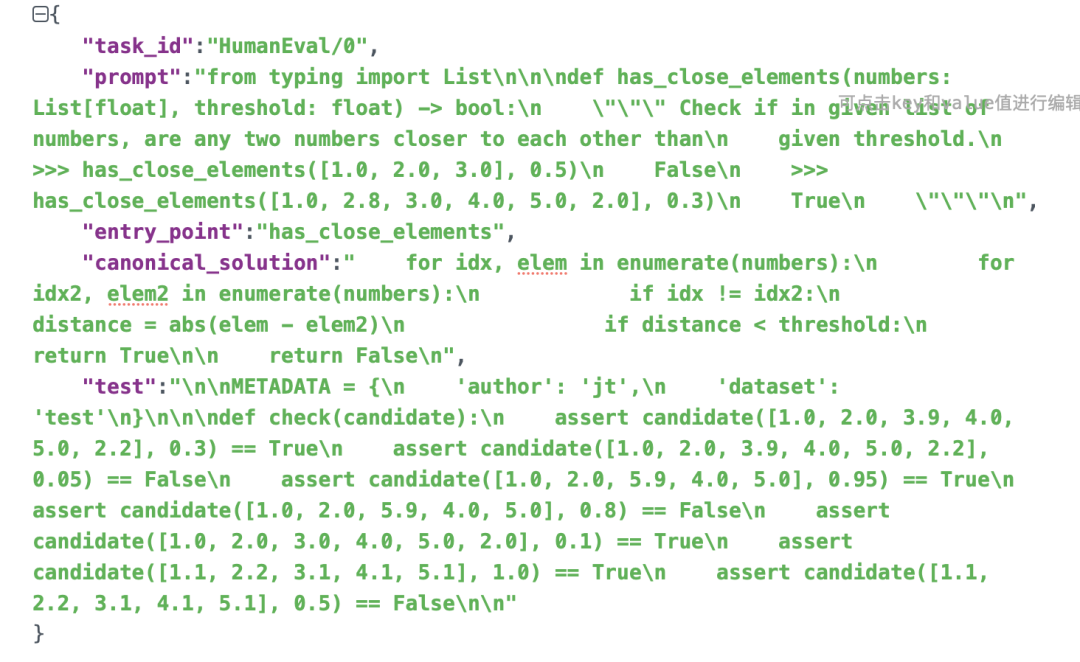HumanEval: Hand-Written Evaluation Set,是工作《Evaluating Large Language Models Trained on Code》(https://arxiv.org/abs/2107.03374)中提到的一个代码评测基准。
最近在做代码方面的评估,走了许多弯路,在评估逻辑上有些误解,重新整理了下,供大家一起参考。尤其是针对pass@k的理解、如何做的单元测试等。
一、HumanEval的数据构成
HumanEval评测数据集,一共包括164条样本,还是很少量的,可以用json进行更为直观的理解,地址https://github.com/abacaj/code-eval/blob/main/human-eval/data/HumanEval.jsonl.gz:
{
"task_id":"HumanEval/0",
"prompt":"from typing import Listnnndef has_close_elements(numbers: List[float], threshold: float) -> bool:n """ Check if in given list of numbers, are any two numbers closer to each other thann given threshold.n >>> has_close_elements([1.0, 2.0, 3.0], 0.5)n Falsen >>> has_close_elements([1.0, 2.8, 3.0, 4.0, 5.0, 2.0], 0.3)n Truen """n",
"entry_point":"has_close_elements",
"canonical_solution":" for idx, elem in enumerate(numbers):n for idx2, elem2 in enumerate(numbers):n if idx != idx2:n distance = abs(elem - elem2)n if distance < threshold:n return Truenn return Falsen",
"test":"nnMETADATA = {n 'author': 'jt',n 'dataset': 'test'n}nnndef check(candidate):n assert candidate([1.0, 2.0, 3.9, 4.0, 5.0, 2.2], 0.3) == Truen assert candidate([1.0, 2.0, 3.9, 4.0, 5.0, 2.2], 0.05) == Falsen assert candidate([1.0, 2.0, 5.9, 4.0, 5.0], 0.95) == Truen assert candidate([1.0, 2.0, 5.9, 4.0, 5.0], 0.8) == Falsen assert candidate([1.0, 2.0, 3.0, 4.0, 5.0, 2.0], 0.1) == Truen assert candidate([1.1, 2.2, 3.1, 4.1, 5.1], 1.0) == Truen assert candidate([1.1, 2.2, 3.1, 4.1, 5.1], 0.5) == Falsenn"
}
如下所示:
task_id表示任务的ID,prompt表示题目(通常直接请求大模型获取答案),entry_point是唯一标记,canonica_solution是参考答案,test是测试单元。
二、HumanEval的评估逻辑
每一个测试问题重复实验n次,然后通过单元测试,计算平均通过率。我们可以在源码地址:https://github.com/abacaj/code-eval/tree/main/human-eval中看到起执行逻辑
1、读取每个样本,请求模型获得结果
如下所示,generate_one_completion为请求大模型生成结果的函数,输入每道题的prompt,然后得到结果。
而由于题目太少,测试结果会有偏,大模型的结果具备多样性(如有top_p, top_k)等,所以,num_samples_per_task用来控制每道题生成多少个结果(代码中设置为200次),从而计算通过率。completion作为补全结果的存储字段。
因此,整体会有32800条样本。
from human_eval.data import write_jsonl, read_problems
problems = read_problems()
num_samples_per_task = 200
samples = [
dict(task_id=task_id, completion=generate_one_completion(problems[task_id][“prompt”]))
for task_id in problems
for _ in range(num_samples_per_task)
]
write_jsonl(“samples.jsonl”, samples)
当然,这一块,需要做一个代码的后处理,因为模型会生成其他多余的代码片段,例如https://github.com/abacaj/code-eval/blob/main/core/evaluation.py中所述:
# reference: https://github.com/declare-lab/instruct-eval/blob/main/human_eval/main.py#L35
def filter_code(completion: str) -> str:
# The program tends to overwrite, we only take the first function
completion = completion.lstrip("n")
return completion.split("nn")[0]
将后处理得到的结果作为最终代码补全结果。
2、获得模型的结果,进行单元测试
这块的逻辑的在于,针对得到的补全结果,通过构造一个完整的测试用例,送入单元测试中进行测试。
其中,如下代码所示:
def check_correctness(problem: Dict, completion: str, timeout: float, completion_id: Optional[int] = None) ->
def unsafe_execute():
with create_tempdir():
# These system calls are needed when cleaning up tempdir.
import os
import shutil
rmtree = shutil.rmtree
rmdir = os.rmdir
chdir = os.chdir
# Disable functionalities that can make destructive changes to the test.
reliability_guard()
# Construct the check program and run it.
print(completion)
check_program = (
problem[“prompt”] + completion + “n” +
problem[“test”] + “n” +
f“check({problem[‘entry_point’]})”
)
try:
exec_globals = {}
with swallow_io():
with time_limit(timeout):
exec(check_program, exec_globals)
result.append(“passed”)
except TimeoutException:
result.append(“timed out”)
except BaseException as e:
result.append(f“failed: {e}”)
# Needed for cleaning up.
shutil.rmtree = rmtree
os.rmdir = rmdir
os.chdir = chdir
manager = multiprocessing.Manager()
result = manager.list()
p = multiprocessing.Process(target=unsafe_execute)
p.start()
p.join(timeout=timeout + 1)
if p.is_alive():
p.kill()
if not result:
result.append(“timed out”)
return dict(
task_id=problem[“task_id”],
passed=result[0] == “passed”,
result=result[0],
completion_id=completion_id,
)
里面对于测试样例的构造,是将题目的prompt、模型预测的内容completion、题目的test的按照换行符进行拼接。
# Construct the check program and run it.
print(completion)
check_program = (
problem["prompt"] + completion + "n" +
problem["test"] + "n" +
f"check({problem['entry_point']})"
)
然后进行单元测试,直接使用python内置的exec函数进行校验,逻辑在于,给定超时timeout时间,如果测试通过,则标记为passed,如果不是,则不通过【比如说出现代码语法错误】。
try:
exec_globals = {}
with swallow_io():
with time_limit(timeout):
exec(check_program, exec_globals)
result.append("passed")
except TimeoutException:
result.append("timed out")
except BaseException as e:
result.append(f"failed: {e}")
经过这个测试之后,就可以得到每条样本的预测情况。
三、再看代码模型评估中的pass@k指标计算
代码生成模型的主要基准是将样本与参考解进行匹配,匹配可以是精确的,也可以是模糊的(如BLEU分数)。
例如:
EM(Exact Match)是指生成的代码与真实代码具有相同的token序列的百分比;
BLUE机器翻译结果越接近专业人工翻译的结果,则越好,本质在判断两个句子的相似程度,相似度越高得分越高。
CodeBLEU是BLEU变体。在BLEU在n-gram匹配上的基础上,进一步通过抽象语法树(AST)融入代码语法,通过数据流融入代码语义;
但是,基于匹配的代码衡量标准存在缺陷。例如,BLEU在捕捉代码特有的语义特征方面存在问题。
因此,Kulal等人(2019年)使用pass@k指标评估功能正确性,每个问题生成k个代码样本,如果任何样本通过单元测试,则认为问题已解决,并报告总分数。
但是一次实验随机性太大,需要多次实验求平均值。pass@k需要对每一个测试问题重复实验t次,并且每次都生成k个代码,最后计算平均通过率。假如重复实验100次来估计pass@100,就需要生成 100*100=10000个代码,这样的计算量是难以接受的。而t越小,估计的pass@k就越不准(方差越大)。
因此,为了评估pass@k,该工作会为每个任务生成n≥k个样本(本文中使用n=200,k≤100),计算通过单元测试的正确样本c≤n的数量,并计算无偏估计值。

其中,c是生成的n个代码中通过测试的数量。n越大估计越准确,但计算代价肯定远远小于t*k。
假设模型只能生成这n个代码,而且他们每一种被生成出来的概率是相等的,其中有c个可以通过测试。那么模型任意生成k个代码,全都不能通过测试的概率是:生成k个不能通过测试的代码的情况总和与生成k个代码的全部情况总和之比,即:

根据大数定理,当样本总量趋近无穷大的时候,样本的平均值无限接近数学期望。因此只要求出其的均值,即得到了对pass@k的无偏估计。
具体代码实现:
def estimate_pass_at_k(
num_samples: Union[int, List[int], np.ndarray],
num_correct: Union[List[int], np.ndarray],
k: int,
) -> np.ndarray:
"""
Estimates pass@k of each problem and returns them in an array.
"""
def estimator(n: int, c: int, k: int) -> float:
“”“
Calculates 1 – comb(n – c, k) / comb(n, k).
““”
if n – c < k:
return 1.0
return 1.0 – np.prod(1.0 – k / np.arange(n – c + 1, n + 1))
if isinstance(num_samples, int):
num_samples_it = itertools.repeat(num_samples, len(num_correct))
else:
assert len(num_samples) == len(num_correct)
num_samples_it = iter(num_samples)
return np.array(
[estimator(int(n), int(c), k) for n, c in zip(num_samples_it, num_correct)]
)
关于这块,https://zhuanlan.zhihu.com/p/653063532做了公式的推演,感兴趣的可以进一步看看。
最终,即可完成对应的指标,例如官方的脚本运行结果:
$ evaluate_functional_correctness data/example_samples.jsonl --problem_file=data/example_problem.jsonl
Reading samples...
6it [00:00, 3397.11it/s]
Running example suites...
100%|...| 6/6 [00:03<00:00, 1.96it/s]
Writing results to data/example_samples.jsonl_results.jsonl...
100%|...| 6/6 [00:00<00:00, 6148.50it/s]
{'pass@1': 0.4999999999999999}
总结
本文主要针对humaneval这一评测任务,从数据、评估逻辑以及pass@k的评估指标计算方式进行了介绍,之前一直对pass@k有误解,认为是预测K次的通过率,读完代码实现本身才有更为准确的理解。
代码评测,也是整个评测体系中十分重要的部分,感兴趣的可关注。
参考文献
1、https://github.com/abacaj/code-eval/blob/main/human-eval/
2、https://arxiv.org/abs/2107.03374
2、https://zhuanlan.zhihu.com/p/653063532
关于我们
老刘,刘焕勇,NLP开源爱好者与践行者,主页:https://liuhuanyong.github.io。
老刘说NLPhttps://zhuanlan.zhihu.com/p/653063532,将定期发布语言资源、工程实践、技术总结等内容,欢迎关注。
对于想加入更优质的知识图谱、事件图谱、大模型AIGC实践、相关分享的,可关注公众号,在后台菜单栏中点击会员社区->会员入群加入。



 ufabet
มีเกมให้เลือกเล่นมากมาย: เกมเดิมพันหลากหลาย ครบทุกค่ายดัง
ufabet
มีเกมให้เลือกเล่นมากมาย: เกมเดิมพันหลากหลาย ครบทุกค่ายดัง






